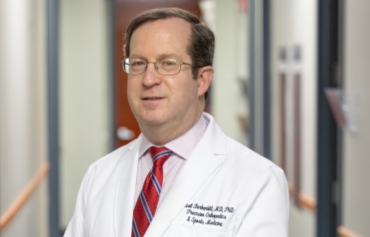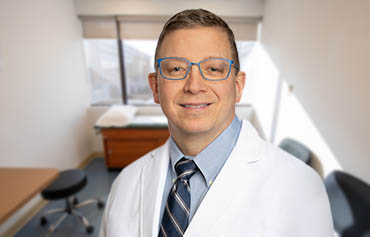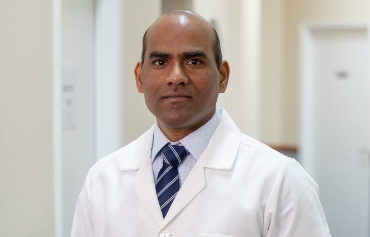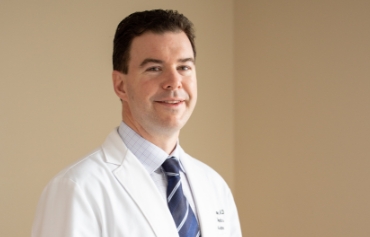Specialties
Hip
Hip pain can disrupt your everyday movements, whether it’s walking, climbing stairs, or even resting. At Precision Orthopedics, our experts use advanced diagnostics and treatment options to relieve hip pain, improve joint function, and help you return to an active, pain-free lifestyle.

Your recovery resource
Learn more about common causes of hip pain, the structure of the hip joint, and how it’s treated.
What causes hip pain?
Hip pain can originate from a variety of sources, including arthritis, bursitis, muscle strain, or injury. It can also be caused by structural problems such as labral tears or impingement.
In younger individuals, hip pain is often related to overuse or athletic injuries, while in older adults, it may stem from degenerative conditions like osteoarthritis. Pain may present in the groin, outer thigh, buttock, or radiate to the knee. Accurate diagnosis is key to proper treatment. surgery, pain, swelling, and stiffness are minimized and recovery is often faster.
What is the structure of the hip joint?
The hip is a ball-and-socket joint formed by the head of the femur (thighbone) and the acetabulum of the pelvis. It is surrounded by a tough capsule, lubricated by synovial fluid, and supported by ligaments, muscles, and cartilage that provide stability and smooth movement.
The labrum — a ring of cartilage — deepens the socket and helps seal the joint. Damage to this structure or wear of the cartilage can lead to pain, stiffness, or mechanical symptoms like catching or locking.
Understanding hip anatomy helps in recognizing the source of pain and choosing the right treatment approach.
What are the most common hip conditions?
Our orthopedic specialists understand every patient’s injury is different. That’s why our team diagnoses the following and other conditions using imaging and physical assessments to create a tailored treatment plan specific to your injury. The most common hip conditions include:
- Hip Osteoarthritis: A degenerative joint condition that leads to cartilage breakdown, causing pain, stiffness, and reduced mobility.
- Hip Fractures: Common in older adults, fractures often require surgery and rehabilitation.
- Hip Labral Tears: Damage to the cartilage surrounding the hip socket, often caused by injury or repetitive motion.
- Trochanteric Bursitis: Inflammation of the bursa (fluid-filled sacs) over the outer hip bone, causing pain on the outer thigh and hip.
- Hip Impingement Syndrome (FAI): A condition where extra bone growth leads to abnormal joint movement, causing pain and stiffness.
How is hip arthritis treated?
Hip arthritis, particularly osteoarthritis, is one of the most common causes of hip pain. It occurs when the cartilage cushioning the joint deteriorates over time, resulting in stiffness, swelling, and reduced range of motion.
We offer a range of treatment options depending on the severity of your condition:
- Physical therapy
- Lifestyle modifications
- Pain management strategies
- Corticosteroid injections
In severe cases, we offer hip replacement surgery. This is offered when mobility is significantly impaired. The procedure replaces the damaged joint with an artificial implant, providing pain relief and restoring function. At Precision, our goal to restore your mobility with the least disruption possible.
What treatment options do you offer for hip pain?
Our specialists create a unique treatment plan for every patient after a thorough assessment. The treatment options include:
- Physical Therapy: Improves mobility, reduces pain, and strengthens the surrounding muscles.
- Medications: Nonsteroidal anti-inflammatory drugs (NSAIDs) and pain relievers.
- Injections: Corticosteroids or hyaluronic acid injections to reduce inflammation and improve joint function.
- Surgical Options: Hip arthroscopy for labral tears, hip resurfacing, and total hip replacement for severe cases.
After treatment, patients are encouraged to follow a customized regimen for recovery. Rehabilitation plays a crucial role in restoring mobility and strength after both non-surgical and surgical treatment. Our structured physical therapy programs are tailored to your stage of recovery, providing the tools you need to manage pain and prevent future injury. Recovery from total hip replacement typically takes 3–6 months, depending on your health and post-surgical progress.
To keep your hips healthy and reduce future injury, we recommend:
- Engaging in low-impact activities like swimming, cycling, and yoga
- Reducing excess weight to minimize joint stress
- Using proper posture and avoiding long periods of sitting
- Incorporating regular stretching and strengthening exercises
Meet our physicians who specialize in hip care:
 Robert Beer, MD
Robert Beer, MD Scott Berkenblit, MD
Scott Berkenblit, MD Gregg Ferrero, MD
Gregg Ferrero, MD Satheesh Ramineni, MD FAAOS
Satheesh Ramineni, MD FAAOS Sameer Saxena, MD
Sameer Saxena, MD Matthew Thompson, MD
Matthew Thompson, MD
Our locations that offer hip support:
Cumberland, MD
Charles Regional Surgical Center
Gaithersburg, MD
La Plata, MD
Laurel, MD
Oxon Hill, MD
Waldorf, MD
White Oak, MD
Make an appointment
If you have an orthopedic need, we have you covered. We can even accommodate new appointments within 24 hours for acute injuries.
View our locations
Find the Precision facility that is closest to you among our 19 locations throughout Maryland and D.C. and give our team a call.